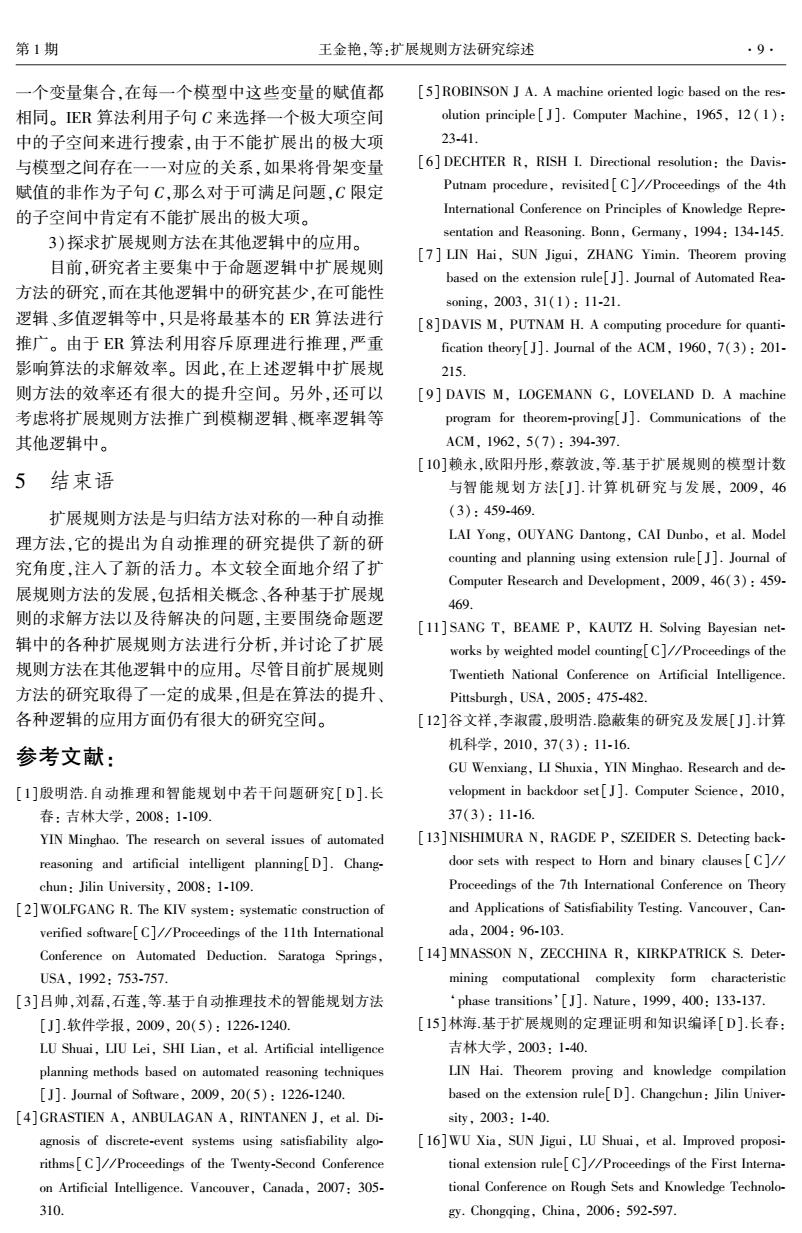正在加载图片...

第1期 王金艳,等:扩展规则方法研究综述 9 一个变量集合,在每一个模型中这些变量的赋值都 5ROBINSON J A.A machine oriented logic based on the res- 相同。ER算法利用子句C来选择一个极大项空间 olution principleJ.Computer Machine,1965,12 (1 ) 中的子空间来进行搜索,由于不能扩展出的极大项 23-41. 与模型之间存在一一对应的关系,如果将骨架变量 [6]DECHTER R,RISH I.Directional resolution:the Davis- 赋值的非作为子句C,那么对于可满足问题,C限定 Putnam procedure,revisited [C]//Proceedings of the 4th 的子空间中肯定有不能扩展出的极大项。 International Conference on Principles of Knowledge Repre- sentation and Reasoning.Bonn,Germany,1994:134-145 3)探求扩展规则方法在其他逻辑中的应用。 [7]LIN Hai,SUN Jigui,ZHANG Yimin.Theorem proving 目前,研究者主要集中于命题逻辑中扩展规则 based on the extension rule J.Journal of Automated Rea- 方法的研究,而在其他逻辑中的研究甚少,在可能性 soning,2003,31(1):11-21. 逻辑、多值逻辑等中,只是将最基本的ER算法进行 [8]DAVIS M,PUTNAM H.A computing procedure for quanti- 推广。由于ER算法利用容斥原理进行推理,严重 fication theory[J].Journal of the ACM,1960,7(3):201- 影响算法的求解效率。因此,在上述逻辑中扩展规 215 则方法的效率还有很大的提升空间。另外,还可以 [9]DAVIS M,LOGEMANN G,LOVELAND D.A machine 考虑将扩展规则方法推广到模糊逻辑、概率逻辑等 program for theorem-proving[J].Communications of the 其他逻辑中。 ACM,1962,5(7):394-397. [10]赖永,欧阳丹彤,蔡敦波,等.基于扩展规则的模型计数 5结束语 与智能规划方法[J].计算机研究与发展,2009,46 扩展规则方法是与归结方法对称的一种自动推 (3):459-469. 理方法,它的提出为自动推理的研究提供了新的研 LAI Yong,OUYANG Dantong,CAI Dunbo,et al.Model 究角度,注入了新的活力。本文较全面地介绍了扩 counting and planning using extension rule[J].Journal of Computer Research and Development,2009,46(3):459- 展规则方法的发展,包括相关概念、各种基于扩展规 469 则的求解方法以及待解决的问题,主要围绕命题逻 [11]SANG T,BEAME P,KAUTZ H.Solving Bayesian net- 辑中的各种扩展规则方法进行分析,并讨论了扩展 works by weighted model counting[C]//Proceedings of the 规则方法在其他逻辑中的应用。尽管目前扩展规则 Twentieth National Conference on Artificial Intelligence. 方法的研究取得了一定的成果,但是在算法的提升、 Pittsburgh,USA,2005:475-482. 各种逻辑的应用方面仍有很大的研究空间。 [12]谷文祥,李淑霞,殷明浩.隐蔽集的研究及发展[J]计算 参考文献: 机科学,2010,37(3):11-16. GU Wenxiang,LI Shuxia,YIN Minghao.Research and de- [1]殷明浩.自动推理和智能规划中若干问题研究[D].长 velopment in backdoor set[J].Computer Science,2010, 春:吉林大学,2008:1-109. 37(3):11-16. YIN Minghao.The research on several issues of automated [13]NISHIMURA N,RAGDE P,SZEIDER S.Detecting back- reasoning and artificial intelligent planning D.Chang- door sets with respect to Homn and binary clauses[C] chun:Jilin University,2008:1-109. Proceedings of the 7th International Conference on Theory [2]WOLFGANG R.The KIV system:systematic construction of and Applications of Satisfiability Testing.Vancouver,Can- verified software[C]//Proceedings of the 11th International ada,2004:96-103. Conference on Automated Deduction.Saratoga Springs, [14]MNASSON N,ZECCHINA R,KIRKPATRICK S.Deter- USA,1992:753-757. mining computational complexity form characteristic 「3]吕帅,刘磊,石莲,等.基于自动推理技术的智能规划方法 'phase transitions'[J].Nature,1999,400:133-137. [J].软件学报,2009,20(5):1226-1240 [15]林海.基于扩展规则的定理证明和知识编译[D].长春: LU Shuai,LIU Lei,SHI Lian,et al.Artificial intelligence 吉林大学,2003:140. planning methods based on automated reasoning techniques LIN Hai.Theorem proving and knowledge compilation J].Journal of Software,2009,20(5):1226-1240. based on the extension rule D.Changchun:Jilin Univer- [4]GRASTIEN A,ANBULAGAN A,RINTANEN J,et al.Di- 8ity,2003:1-40. agnosis of discrete-event systems using satisfiability algo- [16]WU Xia,SUN Jigui,LU Shuai,et al.Improved proposi- rithms[C]//Proceedings of the Twenty-Second Conference tional extension rule[C]//Proceedings of the First Interna- on Artificial Intelligence.Vancouver,Canada,2007:305- tional Conference on Rough Sets and Knowledge Technolo- 310. gy.Chongqing,China,2006:592-597.一个变量集合,在每一个模型中这些变量的赋值都 相同。 IER 算法利用子句 C 来选择一个极大项空间 中的子空间来进行搜索,由于不能扩展出的极大项 与模型之间存在一一对应的关系,如果将骨架变量 赋值的非作为子句 C,那么对于可满足问题,C 限定 的子空间中肯定有不能扩展出的极大项。 3)探求扩展规则方法在其他逻辑中的应用。 目前,研究者主要集中于命题逻辑中扩展规则 方法的研究,而在其他逻辑中的研究甚少,在可能性 逻辑、多值逻辑等中,只是将最基本的 ER 算法进行 推广。 由于 ER 算法利用容斥原理进行推理,严重 影响算法的求解效率。 因此,在上述逻辑中扩展规 则方法的效率还有很大的提升空间。 另外,还可以 考虑将扩展规则方法推广到模糊逻辑、概率逻辑等 其他逻辑中。 5 结束语 扩展规则方法是与归结方法对称的一种自动推 理方法,它的提出为自动推理的研究提供了新的研 究角度,注入了新的活力。 本文较全面地介绍了扩 展规则方法的发展,包括相关概念、各种基于扩展规 则的求解方法以及待解决的问题,主要围绕命题逻 辑中的各种扩展规则方法进行分析,并讨论了扩展 规则方法在其他逻辑中的应用。 尽管目前扩展规则 方法的研究取得了一定的成果,但是在算法的提升、 各种逻辑的应用方面仍有很大的研究空间。 参考文献: [1]殷明浩.自动推理和智能规划中若干问题研究[D].长 春: 吉林大学, 2008: 1⁃109. YIN Minghao. The research on several issues of automated reasoning and artificial intelligent planning[D]. Chang⁃ chun: Jilin University, 2008: 1⁃109. [2]WOLFGANG R. The KIV system: systematic construction of verified software[C] / / Proceedings of the 11th International Conference on Automated Deduction. Saratoga Springs, USA, 1992: 753⁃757. [3]吕帅,刘磊,石莲,等.基于自动推理技术的智能规划方法 [J].软件学报, 2009, 20(5): 1226⁃1240. LU Shuai, LIU Lei, SHI Lian, et al. Artificial intelligence planning methods based on automated reasoning techniques [J]. Journal of Software, 2009, 20(5): 1226⁃1240. [4]GRASTIEN A, ANBULAGAN A, RINTANEN J, et al. Di⁃ agnosis of discrete⁃event systems using satisfiability algo⁃ rithms[C] / / Proceedings of the Twenty⁃Second Conference on Artificial Intelligence. Vancouver, Canada, 2007: 305⁃ 310. [5]ROBINSON J A. A machine oriented logic based on the res⁃ olution principle [ J]. Computer Machine, 1965, 12 ( 1): 23⁃41. [6] DECHTER R, RISH I. Directional resolution: the Davis⁃ Putnam procedure, revisited [ C] / / Proceedings of the 4th International Conference on Principles of Knowledge Repre⁃ sentation and Reasoning. Bonn, Germany, 1994: 134⁃145. [7] LIN Hai, SUN Jigui, ZHANG Yimin. Theorem proving based on the extension rule[J]. Journal of Automated Rea⁃ soning, 2003, 31(1): 11⁃21. [8]DAVIS M, PUTNAM H. A computing procedure for quanti⁃ fication theory[J]. Journal of the ACM, 1960, 7(3): 201⁃ 215. [9] DAVIS M, LOGEMANN G, LOVELAND D. A machine program for theorem⁃proving[J]. Communications of the ACM, 1962, 5(7): 394⁃397. [10]赖永,欧阳丹彤,蔡敦波,等.基于扩展规则的模型计数 与智能规划方 法[J]. 计算机研究与发展, 2009, 46 (3): 459⁃469. LAI Yong, OUYANG Dantong, CAI Dunbo, et al. Model counting and planning using extension rule[ J]. Journal of Computer Research and Development, 2009, 46(3): 459⁃ 469. [11] SANG T, BEAME P, KAUTZ H. Solving Bayesian net⁃ works by weighted model counting[C] / / Proceedings of the Twentieth National Conference on Artificial Intelligence. Pittsburgh, USA, 2005: 475⁃482. [12]谷文祥,李淑霞,殷明浩.隐蔽集的研究及发展[ J].计算 机科学, 2010, 37(3): 11⁃16. GU Wenxiang, LI Shuxia, YIN Minghao. Research and de⁃ velopment in backdoor set[ J]. Computer Science, 2010, 37(3): 11⁃16. [13]NISHIMURA N, RAGDE P, SZEIDER S. Detecting back⁃ door sets with respect to Horn and binary clauses [ C] / / Proceedings of the 7th International Conference on Theory and Applications of Satisfiability Testing. Vancouver, Can⁃ ada, 2004: 96⁃103. [14]MNASSON N, ZECCHINA R, KIRKPATRICK S. Deter⁃ mining computational complexity form characteristic ‘phase transitions’[J]. Nature, 1999, 400: 133⁃137. [15]林海.基于扩展规则的定理证明和知识编译[D].长春: 吉林大学, 2003: 1⁃40. LIN Hai. Theorem proving and knowledge compilation based on the extension rule[D]. Changchun: Jilin Univer⁃ sity, 2003: 1⁃40. [16]WU Xia, SUN Jigui, LU Shuai, et al. Improved proposi⁃ tional extension rule[C] / / Proceedings of the First Interna⁃ tional Conference on Rough Sets and Knowledge Technolo⁃ gy. Chongqing, China, 2006: 592⁃597. 第 1 期 王金艳,等:扩展规则方法研究综述 ·9·